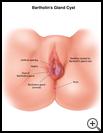
Bartholin's Gland Cyst
________________________________________________________________________
KEY POINTS
- The Bartholin's glands are 2 small glands located in the lower area of the skin folds at the opening of the vagina. You may get a cyst if the opening of the glands is blocked by injury, irritation, or infection.
- Treatment may be simple, such as using warm moist heat on the area, or you may need medicine or minor surgery.
- Ask your healthcare provider how take care of yourself at home and if there are activities you should avoid.
________________________________________________________________________
What is a Bartholin's gland cyst?
A Bartholin’s gland cyst is a fluid-filled swelling of a Bartholin's gland. The Bartholin's glands are 2 small glands located in the lower area of the skin folds at the opening of the vagina (birth canal). There is 1 on each side of the vaginal opening. Each gland has a small tube so fluid can leave the gland and moisten the outer vagina. The fluid made by the glands helps protect the tissues around the vagina and provides lubrication during sex. Normally these glands cannot be felt or seen.
What is the cause?
You may get a cyst if the opening of the glands is blocked by injury, irritation, or infection. When a gland is blocked, fluid builds up and causes swelling.
What are the symptoms?
Symptoms may include:
- Pain, redness, or swelling on one or both sides of the opening of the vagina
- Discomfort during sex
- Feeling of pressure around the vagina
How is it diagnosed?
Your healthcare provider will ask about your symptoms and medical history and examine you, including a pelvic exam.
How is it treated?
Sometimes the cyst will go away if you put warm, moist cloths on it or sit in warm baths. The moist heat may help unblock the opening so that the fluid can drain out.
If the cyst keeps causing problems, your healthcare provider may treat it with one of these procedures:
- Making an opening so fluid can drain. You will be given a local anesthetic to numb the area. Your provider will make a small cut over the gland and put in stitches to keep it open. This lets the fluid keep draining.
- Putting in a catheter. You will be given medicine called anesthesia to keep you from feeling pain during the procedure. You may be given a local anesthetic to numb the area, or general anesthesia, which relaxes your muscles and you will be asleep. Your provider makes a tiny cut in the cyst, and puts in a catheter (a small tube). The catheter helps form an opening to drain fluid that will stay open even after the catheter is removed. Your provider will remove the catheter in 4 to 6 weeks.
Your healthcare provider may prescribe an antibiotic to treat infection.
How can I take care of myself?
Follow your healthcare provider's instructions. Ask your provider:
- How and when you will get your test results
- How long it will take to recover
- If there are activities you should avoid and when you can return to your normal activities
- How to take care of yourself at home
- What symptoms or problems you should watch for and what to do if you have them
Make sure you know when you should come back for a checkup. Keep all appointments for provider visits or tests.
How can I help prevent a Bartholin's gland cyst?
- Clean your vaginal area with mild soap and warm water.
- Avoid hard or deep rubbing in the area around the opening of the vagina.
- If you take long bike rides or ride horses a lot, try to protect your genital area by cushioning it with soft padding. If you sit a lot, take frequent breaks to avoid putting constant pressure on your genital area.

